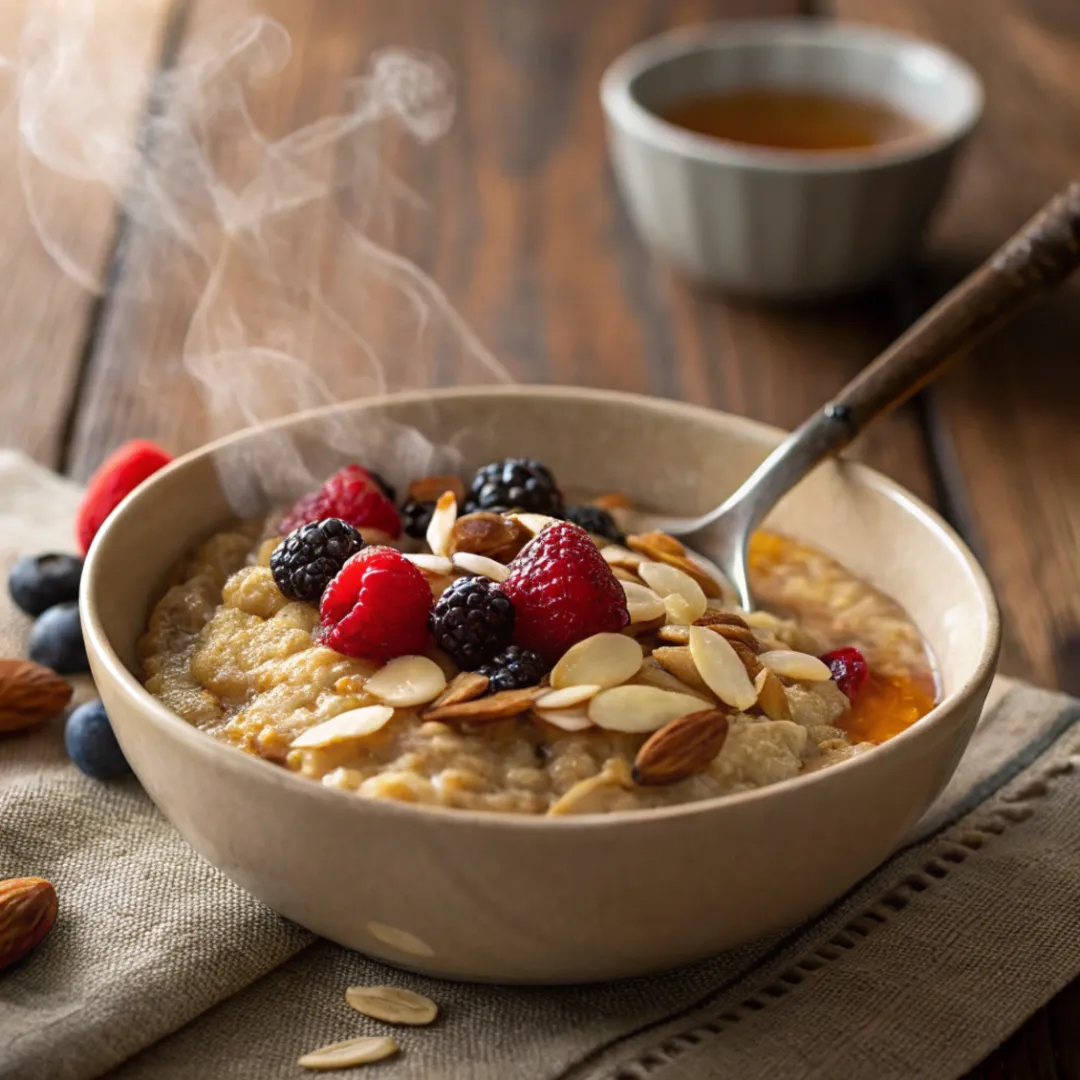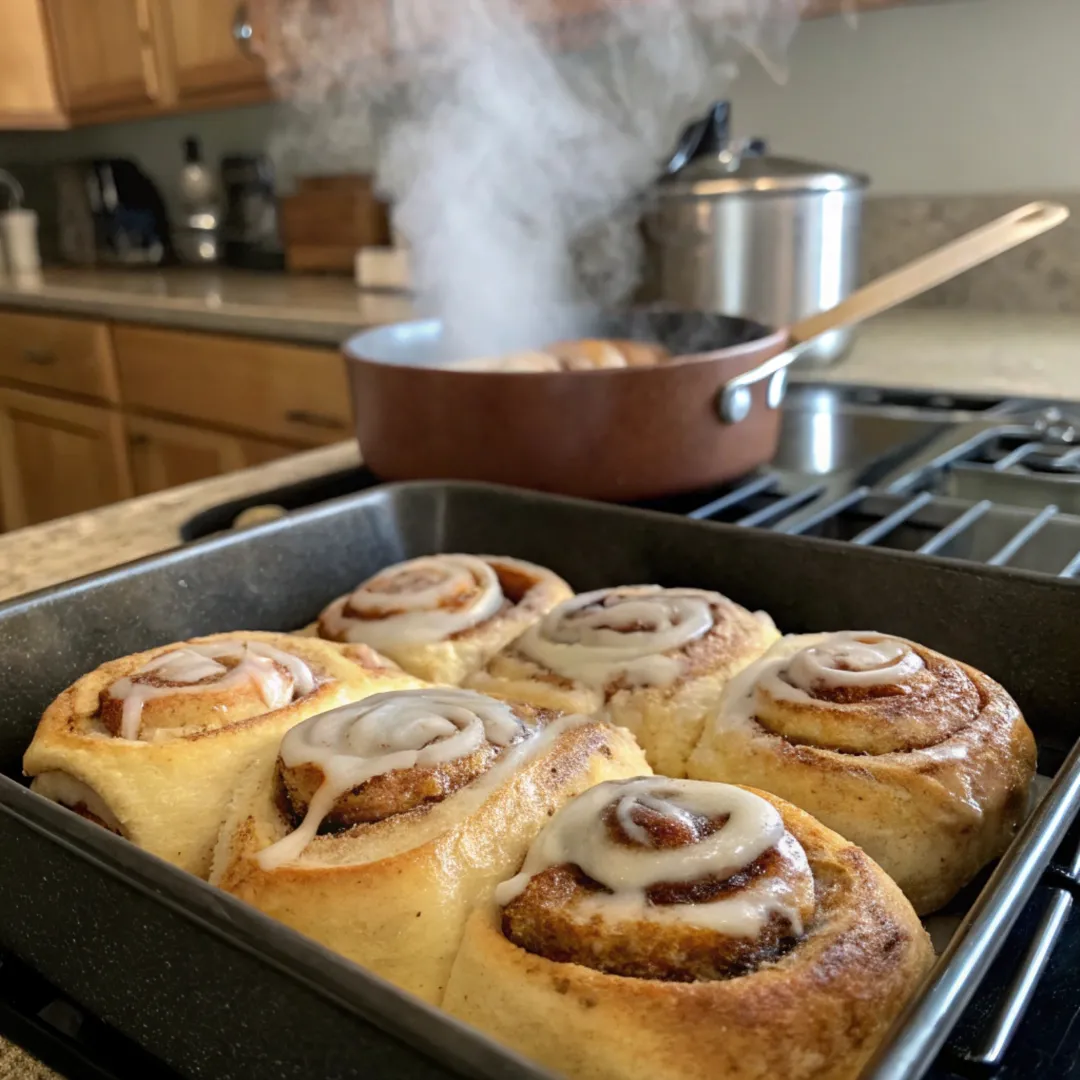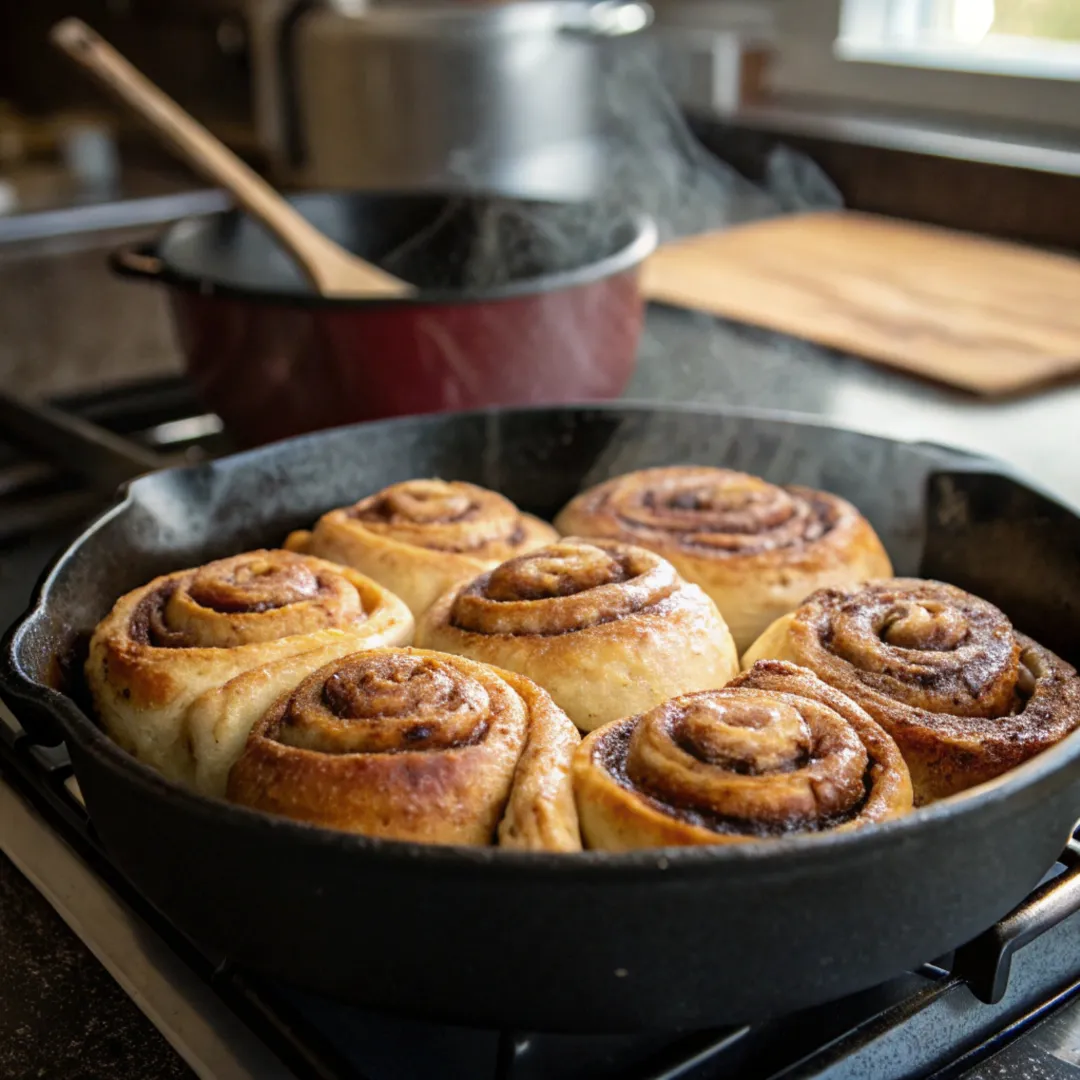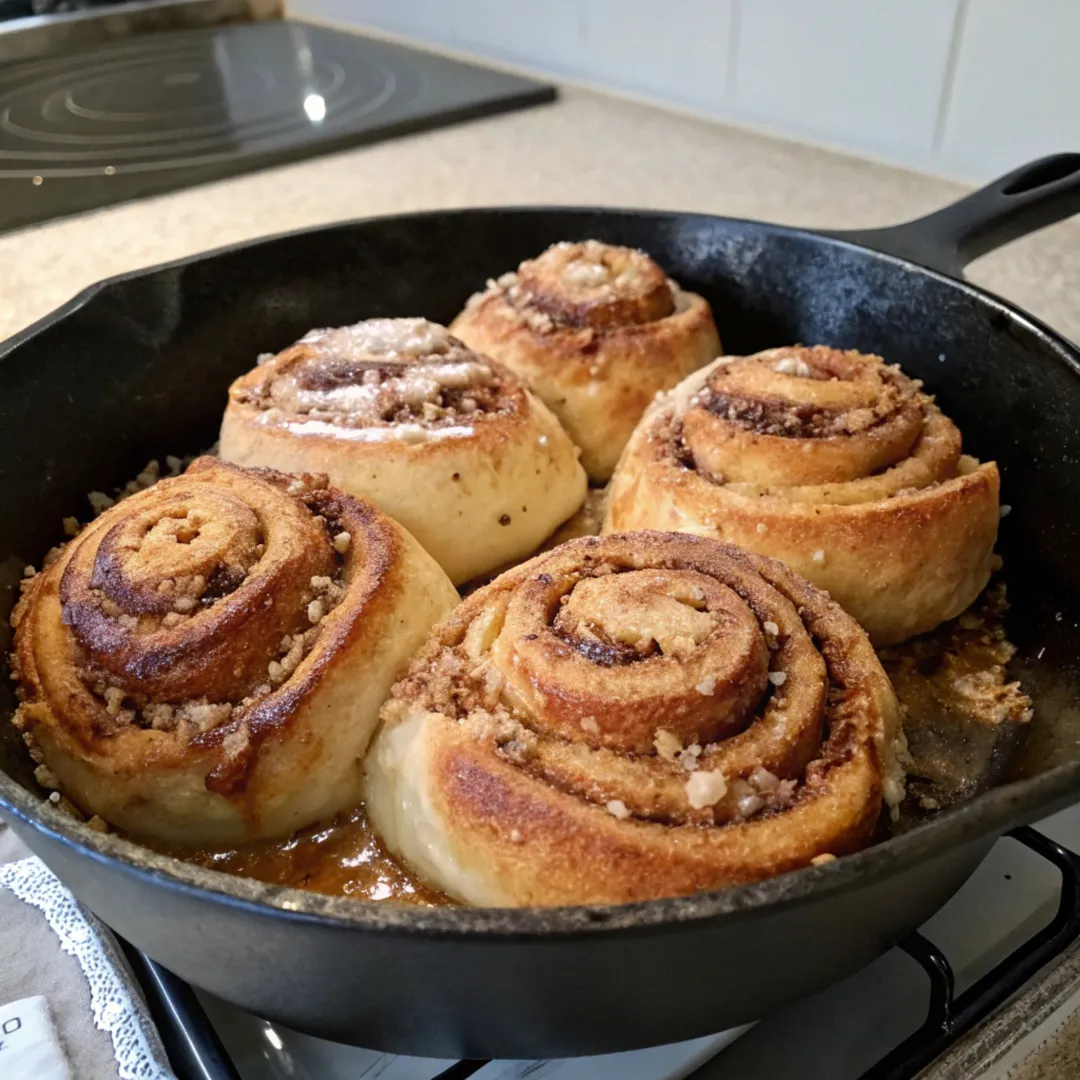
Introduction to Chewy Oatmeal
When you think of oatmeal, the first thing that may come to mind is a warm, hearty bowl of breakfast comfort. But have you ever paused and wondered, what makes oatmeal chewy? For many oatmeal lovers, texture is just as important as taste. Some crave that smooth, creamy bowl that slides off the spoon effortlessly, while others—maybe even you—are on the hunt for that satisfying chew. A bowl that has body, bite, and just the right resistance.
This isn’t just about personal preference—it’s a culinary art. In this article, we’ll unravel the secrets behind chewy oatmeal and show you how to make your bowl absolutely perfect every single time. We’ll dive into oat types, cooking methods, ingredients, and everything else that answers the burning question: What makes oatmeal chewy?
Why Texture Matters in Oatmeal
Let’s be honest—texture can make or break your oatmeal experience. Think of it this way: would you rather eat a bowl of thick, chewy oats that keep you full for hours, or a runny, paste-like mush that tastes like it’s been overcooked in a school cafeteria? Yeah, we thought so.
So, what makes oatmeal chewy instead of mushy or soupy? It’s a combo of the oats you choose, how you cook them, and even what you add to the pot. Texture brings dimension to your breakfast—it slows you down, makes you enjoy each bite, and adds a mouthfeel that’s both hearty and fulfilling. Whether you’re topping it with berries, nut butters, or spices, that chewy bite makes everything pop just a little more.
Moreover, chewy oatmeal tends to be more nutrient-dense and digestively satisfying. That’s right, it’s not just about the bite—it’s about your body loving it, too. When oatmeal is chewy, it often means the oats are less processed, and that’s a win for your blood sugar and gut health.
Still wondering what makes oatmeal chewy in the first place? Let’s start by breaking down the oats.
Understanding Oat Varieties: What Makes Oatmeal Chewy Begins Here
The kind of oats you use is the most foundational part of understanding what makes oatmeal chewy. All oats come from the same whole grain—the oat groat—but how they’re processed changes their texture dramatically.
Steel-Cut Oats: The Chewiest of Them All
Steel-cut oats are the MVP when it comes to chewiness. These oats are literally chopped pieces of the whole oat groat. Unlike rolled or instant oats, they haven’t been steamed or flattened. That means they retain their coarse, hearty structure during cooking.
So what makes oatmeal chewy with steel-cut oats? The structure. It takes longer to cook—upwards of 25 to 30 minutes—but the result is a nutty, chewy texture that’s rich and satisfying. Each bite gives you that slight resistance you’re looking for, a clear sign of minimal processing and fiber-rich goodness.
Pro tip: If you want even more chew, try soaking steel-cut oats overnight before cooking. It softens them just enough for easier cooking while still keeping that chewy integrity intact.
Rolled Oats: A Balanced Texture with a Hint of Chew
Rolled oats, also known as old-fashioned oats, are oat groats that have been steamed and then rolled flat. This processing step helps them cook faster, but they still keep a decent amount of texture. When cooked right, they can deliver a creamy bowl with chewy bits throughout.
Here’s what makes oatmeal chewy with rolled oats: the cook time and the water ratio. If you overcook them or add too much liquid, they turn to mush. But simmer them slowly and use slightly less liquid than the package suggests? Boom—chewy perfection.
Rolled oats are also super versatile. They’re a go-to for overnight oats, baked oatmeal, and stovetop bowls. If steel-cut feels like too much of a time commitment, rolled oats are your best bet for weekday chew.
Quick and Instant Oats: The Chewiness Killers
Let’s get this out of the way—if you’re aiming for chewy oatmeal, skip the quick and instant varieties. These oats are processed for speed: they’re pre-cooked, dried, and then rolled thinner than paper. They’re designed to absorb water quickly, which unfortunately leaves no room for texture.
So what makes oatmeal chewy? Not these. Instant oats practically dissolve the second they hit hot water, resulting in a soft, uniform paste that lacks any real bite. They’re fine if you’re in a time crunch, but if chewiness is the goal, these should be your last resort.

Cooking Methods That Make Oatmeal Chewy
Okay, so you’ve picked your oats—great start. But even the best steel-cut oats can turn to mush if you cook them wrong. The next piece of the puzzle in solving what makes oatmeal chewy is all about how you cook it.
Toasting Oats for Texture and Flavor
This one’s a game-changer. Toasting oats in a dry pan or with a little butter before adding liquid not only enhances their flavor but also helps them hold their shape during cooking. Why? Because the dry heat firms up the outer layer, creating a barrier that resists breaking down too quickly.
Ask any chef, and they’ll tell you: toasting ingredients brings out natural oils and boosts flavor. In oatmeal, it’s a double win—it gives your bowl a deeper, nuttier taste and adds to that chewy bite we’re aiming for. So if you’re still asking what makes oatmeal chewy, start with a toast!
Simmering Slowly vs. Boiling Rapidly
Slow and steady wins the oatmeal race. Rapid boiling breaks down oats too quickly, leaving you with that dreaded mush. Simmering allows the oats to absorb liquid gradually, which is the real secret to that firm, toothsome texture.
So, what makes oatmeal chewy when cooking? Control. Bring your liquid to a boil, add the oats, then immediately reduce to a simmer. Stir occasionally, and don’t rush it. Patience is key. Chewy oatmeal rewards the wait.
The Importance of Liquid-to-Oats Ratio
Here’s where most people go wrong. Too much liquid, and your oats are swimming in sogginess. Too little, and they burn before they ever get tender. The golden ratio for chewy oatmeal? Try 1 part oats to 1.5 parts liquid instead of the usual 2:1.
That slightly reduced liquid means the oats have less to absorb, helping them retain their texture. Especially for rolled or steel-cut oats, this small adjustment makes a huge difference in achieving that ideal chew.
Ingredient Additions That Affect Texture: What Makes Oatmeal Chewy Even Better
You might think the oats and cooking technique are everything when it comes to chewiness—but the ingredients you add can dramatically change the final result. In fact, what makes oatmeal chewy can often be boosted (or ruined) by what you throw into the pot.
Using Nut Butters for Creamy Chew
Nut butters—like almond, peanut, or even cashew—can elevate both flavor and texture. While these aren’t typically associated with chewiness, they can actually enhance the contrast. Here’s how: when added during cooking, nut butters cling to the oats and thicken the mixture without breaking down the grain structure. That leads to a dense, rich oatmeal that still has a bite.
If you’re wondering what makes oatmeal chewy without drying it out or making it overly dense, try stirring in a tablespoon of almond butter during the last few minutes of cooking. It creates a creamy texture that still allows the oats to stand out.
Plus, you get added protein and healthy fats—perfect for a filling breakfast that keeps you energized for hours.
Salt, Spices, and Sweeteners That Complement the Texture
Let’s talk seasoning. While salt and spices won’t directly impact chewiness, they play a role in the sensory experience. Adding a pinch of sea salt helps balance sweetness and intensifies the flavors, making that chewy texture feel more pronounced.
As for spices like cinnamon, nutmeg, or cardamom? These add warmth and complexity, which makes your oatmeal feel more indulgent—and when paired with the right texture, it’s a total win.
And what about sweeteners? Here’s a trick: swap refined sugar for maple syrup or coconut sugar. They’re thicker, which gives your oatmeal more body. And if you’re still asking what makes oatmeal chewy, know this—thicker liquids = more texture control.
Mix-Ins Like Chia Seeds and Nuts for Extra Bite
If you’re really after that satisfying chew, throw in some chia seeds or chopped nuts. These ingredients not only enhance nutritional value but also give your oatmeal more “bite.”
Chia seeds swell slightly when cooked, creating tiny pockets of texture throughout the bowl. Nuts like almonds, pecans, and walnuts remain crunchy and contrast beautifully with the softness of oats. And here’s the kicker—they help your oatmeal retain chewiness even if you accidentally add a little too much liquid.
So again, what makes oatmeal chewy? A smart combination of mix-ins that work with the oats, not against them.
Pro Tips for Perfect Chewy Oatmeal Every Time
Consistency is the holy grail of breakfast. It’s one thing to make chewy oatmeal once—but what if you could get it right every single time? The key to this magic lies in the small details. These are the tricks that answer what makes oatmeal chewy with guaranteed success.
Stirring Techniques That Make a Difference
Believe it or not, how and when you stir your oatmeal matters. Over-stirring can break down oats and turn your pot into a gluey mess. On the flip side, never stirring might leave you with clumps and uneven cooking.
So what’s the secret? Gentle, occasional stirring. Especially with rolled or steel-cut oats, stirring every few minutes encourages even absorption of liquid without compromising structure. You want the oats to mingle with the heat—not be manhandled by your spoon.
This step is critical if your goal is chewy oatmeal. Stir too much or too hard, and you’ll ruin the very texture you’re working so hard to build.
Letting Oats Rest After Cooking
Want to know what makes oatmeal chewy after the heat turns off? It’s called carryover cooking. Letting your oatmeal rest for just 3–5 minutes after cooking allows the oats to firm up and reabsorb any lingering liquid.
Think of it like letting a steak rest after grilling—it makes all the difference. The oats tighten slightly, becoming more defined and chewy, rather than loose and watery. Cover the pot and walk away. When you return, your bowl will be perfect.

Avoiding the Mush Factor: Common Mistakes
Here are the top oatmeal crimes that destroy chewiness:
Too much liquid – Stick to the 1:1.5 ratio.
Boiling on high heat – Simmer gently instead.
Using instant oats – Always opt for steel-cut or rolled.
Over-stirring – Let the oats breathe!
Skipping the rest period – Patience pays off.
If you find yourself asking what makes oatmeal chewy, chances are you’re making one of these rookie mistakes. The good news? They’re easy to fix once you know what to look for.
Expert Opinions and Scientific Insight: Understanding What Makes Oatmeal Chewy
Let’s get nerdy for a second. Because what makes oatmeal chewy is more than just cooking tricks—it’s science. Understanding how oats react to water and heat can give you an edge in perfecting your bowl.
How Oats Absorb Water
Oats contain a unique type of soluble fiber called beta-glucan. When exposed to water, this fiber turns into a gel-like substance. The thicker the gel, the creamier and chewier your oatmeal becomes.
Steel-cut oats absorb water slowly, which allows their structure to remain intact longer—hello, chewiness! Rolled oats soak up water faster, but if controlled correctly, they still give you that bouncy bite.
The trick? Managing absorption by controlling temperature, time, and liquid ratio. That’s the science behind what makes oatmeal chewy.
The Role of Starch and Fiber in Chewiness
Aside from beta-glucan, oats also contain natural starches that swell when heated. However, too much heat or water causes these starches to break down completely, which results in mush.
Fiber content, especially in steel-cut oats, helps prevent over-softening. That’s why high-fiber oats = more texture. So if you’re shopping for oats, look for unprocessed or whole-grain options—they hold their shape and give you that perfect chew.
Simply put, what makes oatmeal chewy is the balance between fiber structure and starch breakdown. Understanding this lets you manipulate the texture like a pro.
Comparisons with Other Breakfast Grains: What Makes Oatmeal Chewy vs. the Rest
Ever wonder how oatmeal stacks up against other grains? Turns out, when it comes to chewiness, not all breakfast bowls are created equal.
Oatmeal vs. Grits
Grits are made from corn, and while they can be creamy, they don’t have the natural chew of oats. Even coarse grits tend to soften more quickly than steel-cut oats. So, when asking what makes oatmeal chewy, it’s clear oats win in the texture department.
Oatmeal vs. Quinoa
Quinoa offers a similar chewy texture, especially when slightly undercooked. However, it lacks the thick, comforting consistency of oatmeal. Plus, quinoa needs rinsing to remove bitterness—oats are ready to go. So, while quinoa is chewy, oats have a more robust bite when cooked right.
Oatmeal vs. Rice Porridge
Rice porridge (like congee) is intentionally soft. It’s creamy and often used for soothing or savory dishes. Chewiness isn’t the goal here. Compared to oatmeal, it lacks that satisfying grain-by-grain resistance that defines a good chew.
Flavor Pairings That Work Well with Chewy Oatmeal
Let’s be real—chewy oatmeal is already a win. But if you want to elevate your bowl to unforgettable, flavor pairings are where it’s at. You’ve nailed the texture, now it’s time to enhance the experience. And believe it or not, certain ingredients can even amplify what makes oatmeal chewy by complementing that satisfying mouthfeel.
Fruits and Berries: Juicy Contrast to Chewy Oats
Fresh fruit adds bursts of flavor and moisture, balancing the chewiness of the oats. Try tossing in sliced bananas, apples, or seasonal berries. The soft texture of ripe fruit contrasts beautifully with firm oats, offering a dynamic mouthfeel.
Here’s the cool part: some dried fruits—like raisins, cranberries, or chopped dates—actually contribute to the chewiness. When added during cooking, they plump up but still retain their chewy core, giving your oatmeal even more bite. So if you’re still wondering what makes oatmeal chewy, try adding a handful of dried cherries or apricots next time. Instant texture upgrade.
Spices Like Cinnamon and Cardamom
We often talk about flavor, but did you know that certain spices can feel textural in the mouth? Cinnamon, for example, isn’t just aromatic—it brings a subtle grainy quality that plays off the chewiness of your oats. Add it during cooking, and it melds with the oats perfectly.
Cardamom, nutmeg, and even ginger offer warm, punchy layers that complement a chewy bowl. It’s not about changing the texture, but enhancing the overall experience. You’re not just tasting oatmeal—you’re enjoying every chewy bite of a gourmet breakfast.
Protein Additions Like Yogurt or Eggs
Want to turn your chewy oatmeal into a powerhouse breakfast? Add protein. A dollop of Greek yogurt on top creates a contrast between cool creaminess and warm chewiness. Scrambled eggs on the side? Even better.
But here’s a secret few know: you can cook a beaten egg into your oatmeal. It thickens the mixture, ups the chew factor, and gives it a custardy texture you won’t believe. Suddenly, the answer to what makes oatmeal chewy includes one more ingredient—eggs!
Vegan and Gluten-Free Chewy Oatmeal Tips: What Makes Oatmeal Chewy Without Compromising Diet
If you’re vegan or gluten-intolerant, you’re in luck. Oats are naturally gluten-free (just be sure they’re certified), and you can absolutely make chewy, satisfying oatmeal without any animal products.
Dairy Alternatives That Work
If you’re ditching dairy, you’ve got plenty of plant-based options. Almond milk, oat milk, coconut milk, and soy milk all create different textures. For chewiness, go for thicker options like full-fat coconut milk or creamy oat milk. Thinner milks may water down your oats, softening that chewy texture we love.
You can also add coconut cream or plant-based yogurts after cooking to boost both creaminess and chewiness. Again, texture contrast is your friend.
So, what makes oatmeal chewy on a vegan diet? The right plant-based ingredients paired with smart cooking techniques.
Certified Gluten-Free Oats: Choosing the Right Kind
Some oats are processed in facilities with wheat, so be sure to choose certified gluten-free oats if you’re avoiding gluten. The good news? Gluten-free steel-cut and rolled oats are just as chewy—sometimes even chewier—than traditional varieties.
And here’s a trick: let your oats soak overnight in non-dairy milk, then cook them low and slow. That method enhances their natural chew while staying 100% gluten-free. The result? A chewy bowl that checks every dietary box and still leaves you wondering why everyone isn’t eating oatmeal this way.
Chewy Oatmeal for Meal Prepping: How to Keep What Makes Oatmeal Chewy Lasting All Week
Busy mornings? No problem. You can meal prep chewy oatmeal and enjoy perfect texture all week long. The key is to cook it just right, store it properly, and reheat it the smart way.
Storage and Reheating Tips
First things first—let your oatmeal cool completely before storing. This prevents condensation from building up and turning your perfectly chewy oats into a soggy mess. Use airtight containers and store in the fridge for up to five days.
When reheating, skip the microwave if possible. Instead, use the stovetop with a splash of milk or water, stirring gently. This allows you to maintain or even revive that chewy texture. Microwaving, on the other hand, can overcook the oats and kill the chew.
Want to keep it even simpler? Store your oatmeal in individual jars and reheat in a hot water bath. It’s hands-free and chew-friendly.
Batch Cooking and Texture Maintenance
The best way to make chewy oatmeal in bulk? Use steel-cut oats. They hold their texture better over time, making them ideal for meal prep. Cook a big batch using the 1:1.5 ratio, let it rest, portion it out, and refrigerate.
If you’re still asking what makes oatmeal chewy over several days, the answer is proper portioning and reheating. Never reheat the whole pot at once—it’s better to warm it in small amounts to maintain texture and flavor.
Bonus tip: Add fresh toppings each day. This keeps things interesting and ensures every bowl feels like it was made just for that moment.
Frequently Asked Questions: What Makes Oatmeal Chewy? Your Top Queries Answered
Let’s wrap up this section with answers to the most common chewy oatmeal questions. These quick tips might just be the missing puzzle piece for your perfect bowl.
Why Is My Oatmeal Still Mushy?
If your oats are turning into glue, it’s likely one of three things: too much liquid, too high heat, or the wrong type of oats. Go for steel-cut or rolled, use less water, and simmer low and slow. That’s what makes oatmeal chewy instead of mushy.
Can I Use Milk Instead of Water?
Absolutely! Using milk (dairy or non-dairy) adds richness and density. It slows absorption slightly, which can lead to a chewier texture. For best results, use a mix of milk and water in a 50/50 ratio.
How Do I Fix Overcooked Oatmeal?
Add a bit of rolled oats and cook for just a minute or two to restore some bite. Alternatively, stir in chia seeds or flaxseed to thicken and add texture. While it won’t be perfect, it’ll bring back some chew.
Can Overnight Oats Be Chewy?
Yes, especially if you use rolled oats and limit the liquid. Add less milk than usual, and let them soak for just 6–8 hours. That slight firmness mimics chewiness quite well.
Is Chewy Oatmeal Healthier Than Creamy?
Not necessarily, but chewy oatmeal often uses less processed oats, which retain more fiber and nutrients. Plus, they’re more filling, helping with appetite control and digestion.
Conclusion: Mastering What Makes Oatmeal Chewy
Chewy oatmeal isn’t just a trend—it’s a revelation. It’s a sensory upgrade from the bland, soggy bowls you may have settled for in the past. From oat type to toasting, stirring to simmering, now you know exactly what makes oatmeal chewy and how to achieve it.
Remember, the secret lies in:
Choosing the right oats (steel-cut or rolled)
Using the perfect liquid ratio
Cooking low and slow
Letting it rest
Adding the right ingredients for extra texture
Whether you’re a breakfast traditionalist or a kitchen adventurer, mastering the art of chewy oatmeal will make your mornings infinitely more satisfying. Start experimenting, play with flavors, and make chewy oatmeal your signature dish.
FAQs
1. How can I make my instant oats chewy?
You really can’t—they’re too processed. Opt for rolled oats instead for a better shot at chewiness.
2. Do chewy oats take longer to cook?
Yes, but the payoff is huge. Steel-cut oats take longer but reward you with amazing texture.
3. Can I make chewy oatmeal in a slow cooker?
Yes! Use steel-cut oats, set it to low, and cook overnight. You’ll wake up to perfect chew.
4. Should I rinse my oats before cooking?
Not necessary, but some people do it to remove extra starch. This might reduce creaminess, though—not chewiness.
5. What’s the best topping for chewy oatmeal?
Go with contrast—crunchy nuts, fresh fruit, or a drizzle of creamy nut butter to balance every bite.



